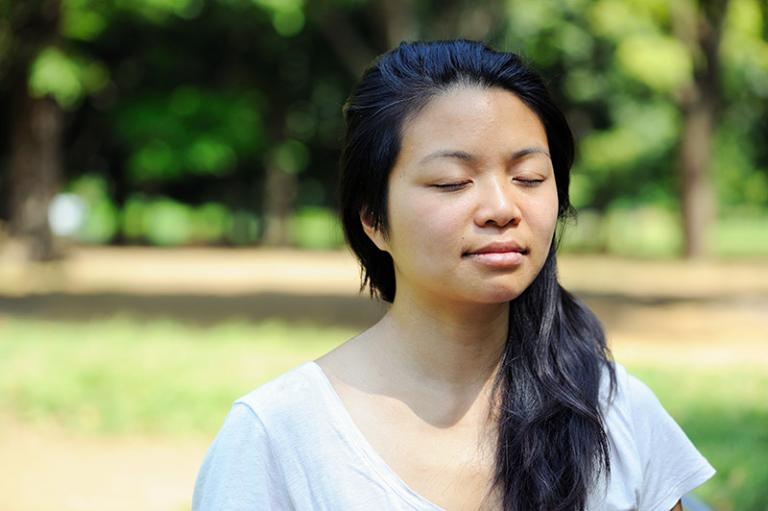
Of the many techniques I have created and incorporated into my Brain Education method, seven are most useful and form the foundation of the practice: breathing, meditation, energy sensitivity, exercise, senses, information, and imagination. Over the course of the next few months in my Patheos blog posts, I will write about each one of them and will introduce some practical tips for using them.
The first tool is one you have been doing since your first day on Earth: breathing.
Your brain breathes, literally!
Did you know that the brain’s nerve cells are more sensitive to oxygen supply than any other cells? The brain suffers immediate damage when its oxygen supply is cut off, even if for just five minutes. And, although the brain makes up no more than about eight percent of the body’s mass, it accounts for about a quarter of the body’s calorie expenditure. Calories are used in bonding oxygen with nutrients, so breathing is a prerequisite for energy production.
To put it another way, the human organ that breathes the most is the brain. That’s why expressions such as “the brain breathes” and “I breathe with my brain” are more than metaphorical.
Why is breathing important for brain development?
Breathing, pulse, blood pressure, body temperature—these are all vital functions controlled by the autonomic nervous system. In other words, our bodies take care of themselves, without our intentionally regulating them. Breathing is unique among these autonomic functions because it can be intentionally controlled the most effectively, and it is the most basic and essential activity for maintaining life. We don’t pay special attention to it, though, because it happens naturally, whether or not we try to control it.
Purposely raising or lowering blood pressure, pulse, or body temperature isn’t easy; only the most skilled people can do so. Intentionally speeding up or slowing down breathing, however, can be accomplished by anyone. And we can indirectly affect our other vital signs, such as blood pressure, pulse, and body temperature, through breath control. In fact, we can control more than the body’s physiological functions through breathing. We can control our minds—our thoughts and emotions. This is why I consider breathing such an important tool for brain development.
Not all breathing is the same, however. There’s rough, irregular breathing, and there’s controlled, deep, and gentle breathing. You can bring great, positive change to your body, and especially your brain—if you learn to breathe well.
A Proven Way to Destress and Energize
Breathing exercises are a classic mind-body-spirit practice, but science has confirmed the value of breathwork. Here are some of the benefits scientific studies have confirmed:
- Slows your resting heart rate. A high resting heart rate is associated with higher mortality, and breathing is the quickest way to lower your heart rate.
- Brings energy to the cells. When you breathe slowly and deliberately, more oxygen enters the bloodstream, which in turn helps the cells of the body make more energy.
- Reduces stress hormones in the body. Breathing effectively turns off the stress response in the body by lowering the production of stress hormones.
- Improves lung function. Breathing can greatly improve lung capacity and remove pollutants from the lung structures.
Here are two simple breathing exercises that can revitalize your life:
Chest Breathing
This simple breathing exercise is the easiest and most natural for beginners, and it is also one of the most effective for anyone. It is especially good for someone who is dealing with emotional situations or experiencing pressure and stress at work.
- Lie down on the floor on a firm but comfortable surface. Bring your arms out to the side with palms facing the ceiling, and part your legs about shoulder width.
- Begin to breathe at a natural pace and depth, but focus your attention at the center of the chest. Try to let all other thoughts leave your mind. Focus only on the up and down movement of the chest as you breathe in and out. If your mind begins to wander, just bring your focus back to the rise and fall of the chest.
- As you breathe, allow your body to become more and more deeply relaxed. With each exhalation, imagine that your body is becoming like a pool, sinking more and more deeply into the floor.
- Continue for 5 or more minutes, adding time as you become more experienced.
- When you are ready to end your session, slowly open your eyes and shake out your arms and legs. Sit up and then stand up slowly and deliberately.
Abdominal Breathing
After you become proficient at chest breathing, give abdominal breathing a try. This one is even healthier because the breath goes deeper, all the way into the lower abdomen.
- Lie down on the floor on a firm but comfortable surface. Bring your arms out to the side with palms facing the ceiling, and part your legs about shoulder width.
- Begin to breathe at a natural pace and depth, focusing at first on the movement of your chest. Try to let all other thoughts leave your mind.
- Begin to bring your focus down to the lower abdomen. Feel your abdomen expand and contract like a balloon. If your mind begins to wander, just bring your focus back to the rise and fall of the abdomen. Imagine that energy is entering your body with each breath, pooling in the lower abdomen.
- As you breathe, allow your body to become more and more deeply relaxed. With each exhalation, imagine that your body is becoming like a pool, sinking more and more deeply into the floor.
- Continue for 5 or more minutes, adding time as you become more experienced.
- When you are ready to end your session, slowly open your eyes and shake out your arms and legs. Sit up and then stand up slowly and deliberately.
In the next post, we will investigate one of the most powerful of all mind-body exercises: meditation. Through it, you can find serenity and centeredness that will truly revolutionize your life.












